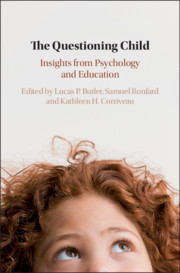Book contents
- The Questioning Child
- The Questioning Child
- Copyright page
- Dedication
- Contents
- Figures
- Tables
- Contributors
- 1 Questions about Questions
- 2 Questions in Development
- 3 The Point, the Shrug, and the Question of Clarification
- 4 The Quest for Comprehension and Learning
- 5 Children’s Question-Asking across Cultural Communities
- 6 The Development of Information-Requesting Gestures in Infancy and Their Role in Shaping Learning Outcomes
- 7 Developmental Changes in Question-Asking
- 8 Understanding Developmental and Individual Differences in the Process of Inquiry during the Preschool Years
- 9 “Why Are There Big Squares and Little Squares?”
- 10 Children’s Questions in Social and Cultural Perspective
- 11 Mothers’ Use of Questions and Children’s Learning and Language Development
- 12 Teaching and Learning by Questioning
- 13 Asking “Why?” and “What If?”
- 14 What Makes a Good Question? Towards an Epistemic Classification
- 15 The Questioning Child
- Index
- References
3 - The Point, the Shrug, and the Question of Clarification
Published online by Cambridge University Press: 10 January 2020
- The Questioning Child
- The Questioning Child
- Copyright page
- Dedication
- Contents
- Figures
- Tables
- Contributors
- 1 Questions about Questions
- 2 Questions in Development
- 3 The Point, the Shrug, and the Question of Clarification
- 4 The Quest for Comprehension and Learning
- 5 Children’s Question-Asking across Cultural Communities
- 6 The Development of Information-Requesting Gestures in Infancy and Their Role in Shaping Learning Outcomes
- 7 Developmental Changes in Question-Asking
- 8 Understanding Developmental and Individual Differences in the Process of Inquiry during the Preschool Years
- 9 “Why Are There Big Squares and Little Squares?”
- 10 Children’s Questions in Social and Cultural Perspective
- 11 Mothers’ Use of Questions and Children’s Learning and Language Development
- 12 Teaching and Learning by Questioning
- 13 Asking “Why?” and “What If?”
- 14 What Makes a Good Question? Towards an Epistemic Classification
- 15 The Questioning Child
- Index
- References
Summary
Early studies of children’s questions focused primarily on the epistemic motive that prompted them. Increasingly, however, investigators have recognized that questions are situated within a dialogue in which the child’s interlocutor and the answers that the interlocutor supplies are likely to determine what children learn from their questions and the broader stance that children take to curiosity–driven conversations. Moreover, children do not ask questions with one single motive. Many of their questions are aimed at gathering information about the world but some are aimed at securing help, or permission or clarification of what has just been said. Even in the second year of life toddlers use nonverbal gestures such as pointing to seek input from a partner. Such gestures appear to be interrogative in the sense that information provided in their wake is especially well remembered. Toddlers also signal their ignorance again nonverbally via shrug gestures but increasingly via explicit admissions of ignorance: “I don’t know.” Finally, despite the alleged lack of metacognitive awareness among young children, they are prompt in seeking to resolve comprehension glitches by asking clarification questions.
- Type
- Chapter
- Information
- The Questioning ChildInsights from Psychology and Education, pp. 29 - 50Publisher: Cambridge University PressPrint publication year: 2020
References
- 5
- Cited by

